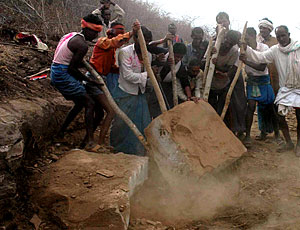Exasperated with neglect from the government of India’s eastern state of Bihar, two remote villages on top of a hill have built a 4-kilometer-long road using the most basic tools, including hammers, chisels and trowels. Barwan Kala and Barwan Khurd, located in the forested Kaimur Hills, have a combined population of 3,000. most of whom are farmers.

“We are cursed,” says Chandrama Yadav, a local resident involved in the construction work in an exclusive to ENR. “Over 100 men between 30 and 60 years are not married in our village, and nobody wants to marry our daughters because of the sheer logistics of reaching us. Besides, whenever there is a medical emergency, we have to carry the patients on stretchers made of bamboo and blankets downhill, and often it’s too late.”
The villages are accessible only by footpath along steep terrain or by helicopter. The road was chiseled out of the footpath using blacksmiths’ hand tools including hammers, anvils and chisels. Soft rocks found uphill were broken by hammers and leveled. Big boulders were moved to the side using long iron rods as levers. The narrow walking track surrounded by a forested area was widened to 3.6 meters, to ensure a jeep or a tractor could be driven on it. Around 200 people from the villages worked every day for four months to construct, level and broaden their road.
But India’s notorious red tape may yet strangle the project. With 2.5 km left to construct, local forest department officers say the villagers violated regulations by cutting away at the hill without the department’s permission.
“This area is a protected sanctuary area. No operation is allowed, including electrification and roads,” says R.K. Ram, Bihar’s deputy forest officer. “The villagers need to get the approval of the forest department that will, in turn, approach the Supreme Court for permission before the rest of the road is completed. There is already a case in court against the villagers for encroachment” because of the road, he says.
The road also must be connected to existing roads. But the geology at the bottom of the hill requires more than hand labor because of hard rock. “This will require technical expertise by way of blasting of the rock and sloping the road, including designing the road at the correct angle,” Yadav says. The power of bare hands will no longer help as the boulders are hard, requiring a hard-rock trench-cutting machine costing approximately $3,000, he adds.
A local temple of the International Society for Krishna Consciousness that helped the villagers with buying the basic tools says it is willing to help if the government agrees to chip in. But government help is unlikely.
Beginning in 1967, a Bihar resident, Dashrath Manjhi, living in the hills and faced with similar issues, took 22 years to finish by himself a 110-m-long, 9-m-wide road using a chisel, hammer and shovel. Once a precarious passage just 30 cm wide, it is now used by 60 villages, reducing the distance to the nearest town from 50 km to just 10 km. Promises to Manjhi by Bihar’s chief minister for material support remain unfulfilled.


Post a comment to this article
Report Abusive Comment